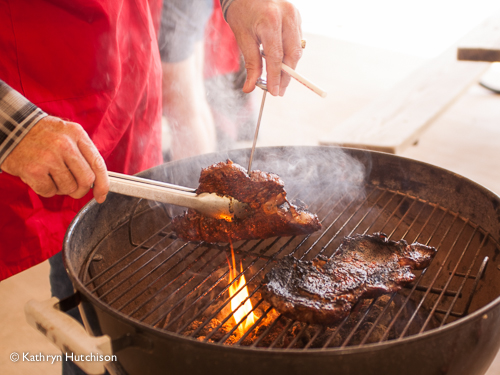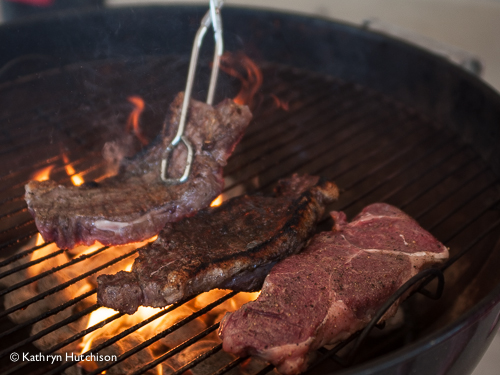If you take a quick glance at my recipe collection, you’ll see tons of desserts, salads, and sides, but nary a grilled dish in sight. I’m embarrassed to admit, until last weekend I had never even lit a grill before! Spending my 20s bouncing from one apartment to the next, I never put much effort into learning how to grill, much less investing in the appropriate equipment.
Now that I finally live in a home with a backyard (and a charcoal grill, thanks to David), it is time to tackle my grilling anxiety once and for all! Towards this end, David and I treated ourselves to a Grilling 101 class last weekend, which was presented by the Austin Food Blogger Alliance and the Texas Beef Council.
Chef Tiffany Blackmon taught David, me, and a group of about 15 other bloggers the tricks of the trade, perfect for newbies like me. We also got some hands-on practice at lighting a charcoal grill, and grilling several different cuts of beef. Here are 11 of my favorite tips from the class:
1. Choose the best cuts of beef for grilling.
When it comes to the grill, all cuts of beef are definitely not created equal. Rib, loin, and sirloin are the best cuts of steak for grilling since they come from the most tender parts of the cow. When in doubt, ask your butcher for help selecting a cut of beef, or visit Texas Beef Council’s website for a list of the best cuts of beef for grilling.
Recommended steaks for grilling include:
- Tri-Tip
- Porterhouse/T-bone
- Ribeye
- Filet
- Sirloin Tip Center
- Flat Iron
- Skirt (only if marinated 6-24 hours to tenderize)
- Flank (only if marinated 6-24 hours to tenderize)
Avoid grilling the following cuts of beef. These are better suited to cooking methods like smoking, slow cooking, or stewing:
- Round Steaks
- Stew Meat
- Ribs
- Cubed Steak

2. You don’t need to spend a lot of money.
I had always assumed that grilling beef would be expensive. The filet pictured above costs nearly $25 per pound! It’s certainly worth a splurge, but there are so many other choices for everyday value. Chef Blackmon recommends the Chuck Eye, Tri-Tip, and Top Sirloin Steaks if you are grilling on a budget, no marinade needed! Flank, Skirt, and Eye of Round are excellent, affordable cuts of beef for grilling as long as you marinate them for 6-24 hours to tenderize them first. Stretch your budget even further by using beef in recipes where it can be sliced before serving, such as fajitas, steak salads, and crostinis. Each steak can feed several people if it’s combined with other ingredients.
3. This little-known cut is almost as tender as filet, for less than half the price!
The flat iron steak comes from the top blade roast, a somewhat tougher cut of meat from the cow’s shoulder. To make a flat iron steak, the butcher removes a line of connective tissue from the roast and cuts only the most tender parts of the meat into steaks. What remains are large, flat steaks that are second only to the filet in tenderness. With its large size and $10 per pound price point, the flat iron steak is one of the most budget-conscious choices for grilling at the butcher counter. It’s a pretty new cut of meat, so you might need to special order at the butcher counter.
4. Use a marinade to add flavor and/or tenderize.
There are two reasons to marinate beef before grilling: to add flavor, or to tenderize the meat. For tender steaks like T-Bone or Strip, marinate for up to 2 hours to infuse beef with juicy flavor. Any longer than that, and your steak might get mushy. For less tender cuts like Flank or Skirt Steak, use a marinade with acid in it (vinegar, for example) for six-24 hours. This will gently season the meat, and the acids in the marinade will break down the meat so that it stays tender on the grill. Use 1/4 cup marinade for each pound of beef, and always marinate beef in the refrigerator.
5. Make your own spice rub.
Many commercial spice rubs are made of mostly salt– what a rip off! Combine your favorite spices right from your pantry for an inexpensive, easy beef seasoning. Dry rubs are best for grilling. Apply a small amount of olive oil to the steak, and then rub in the spices in up to 2 hours before the beef goes on the grill. 
6. Is charcoal grilling better than gas grilling?
It depends. Charcoal grills are inexpensive, and this cooking method infuses the meat with the most flavor. Gas grills can offer more precision during cooking, and are generally easier to operate and clean.
7. Heat your grill to 400° F.
The correct temperature for grilling is 400 degrees. Cook too hot, and your meat will be tough. Cook too cool, and the grill will fizzle before the meat is done.
8. Always follow the 4-4-4 rule.
The 4-4-4 rule is an easy way to tell when the grill is ready. My friend Kristin summed this up best in her recap of the class: hold 4 fingertips, 4 inches above the grill, for 4 seconds. If you have to remove your fingers before 4 seconds then the grill is too hot, longer than 4 seconds and the grill isn’t hot enough.
9. Only flip once!
Once the meat is on the grill, it loses moisture and flavor every time you disturb it. To keep your steak moist and juicy, flip it just once, halfway through cooking. You can tell that steak is ready to flip once the edges are deep brown in color with black grill marks, and moisture is pooling in the top middle of the steak. Have patience! Just flip once!

10. Use a meat thermometer every time.
This was the #1 tip Chef Blackmon gave during the class. Since grilling times vary widely, a meat thermometer is the only foolproof way to tell when meat is cooked perfectly. There are a few tricks to make sure your thermometer is working correctly:
- Calibrate your thermometer by dipping it into ice water. It should read 32° F. If it’s off by a few degrees, take that into account when measuring meat later on.
- Most dial meat thermometers have a temperature sensor from the pointed tip up to the notch, or dimple, on the side of the thermometer. To get an accurate reading, place the thermometer into the side of the steak, all the way up to the notch.

10. This trick will help you avoid overcooking your beef.
With the exception of ground beef, which should always be cooked to 160° F, you can customize your grilling experience by cooking your beef as rare or well done as you like! The secret to tender, juicy steaks, is to remove the beef from the grill 5-10 degrees before it reaches the maximum cooking temperature. Then let the beef rest for 5 minutes before serving.
For example, the maximum cooking temperature for a medium rare steak is 145° F. To hit this temperature without going over, remove the steak from the grill once it reaches 135-140° F, and let it rest on a clean plate or cutting board for a few minutes before serving. During this resting time, the juices will settle back into the steak, and the internal temperature of the meat will continue to rise. Once the steak is ready to serve, it will be tender and moist!

